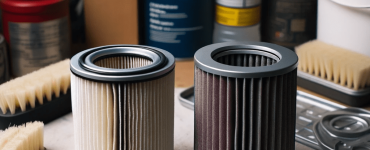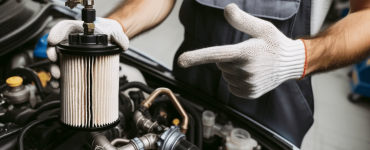What You Need To Know Before Restoring a Car’s Steering Wheel
Are you ready to take on the challenge of restoring a car’s steering wheel? It can be a fun and rewarding experience, but there are some important things you need to know before getting started. From choosing the right restoration parts for your vehicle to understanding how leather steering wheel repairs work, we have everything you need to know about restoration steering wheels.

Understand the Different Types of Steering Wheels
There are several different types of steering wheels, including leather, plastic, and aluminum. Each type requires different techniques for restoring them.
It’s important to understand which type you have before attempting any work. This will help you to choose the right tools and materials for the job!
Leather
Leather upholstery wheels have become a popular choice in many car brands. BMW, Mercedes-Benz, Audi, Lexus and Volvo are some of the most well known luxury car companies that offer leather steering wheels in their vehicles. Not only do leather steering wheels look great, but they also provide a great grip.
Plastic
Many mainstream car brands such as Honda, Toyota, Ford, Nissan, Volkswagen, Hyundai and Kia offer plastic wheels in their vehicles. Plastic ones provide a good grip and can also be customized with different casings.
Aluminum
Aluminum wheels are the rarest of all, but they are definitely the most luxurious. They have a unique look and feel that sets them apart from other types of steering wheels. Their lightweight construction makes them ideal for performance driving. Many luxury car brands such as Porsche, Maserati, Lamborghini have them.
Wood
Wood steering wheel cover are a rarity amongst car brands, but there are still some that offer them. One of the most well known is Mercedes-Benz, which has a range of luxurious and unique wood steering wheel covers for their cars. These wheels feature a combination of materials such as genuine leather and handcrafted wood.
Canvas
Canvas wheels are a unique and eye-catching addition to any car. While not as widely available as leather, plastic or aluminum steering wheels, canvas steering wheel cover can still be found in certain vehicle brands.
Jeep is one such brand that offers canvas steering wheels for some of its vehicles.
Cork
Cork custom cover are becoming a popular choice for car owners looking to add a unique touch to their vehicle.
While not as widely available as other types of steering wheels, cork steering wheels can still be found in certain luxury vehicle brands. Porsche, Mercedes-Benz and Lamborghini are some of the most well known car brands who use them.
Rubber
Rubber steering wheels are a great choice for those who want a durable and long-lasting steering wheel. While not as widely available as other types of steering wheels, there are still some car brands that use them. Jeep is one such brand that offers rubber steering wheels on some of their vehicles.

Determine Whether to Restore or Replace Your Steering Wheel
When it comes to restoring a car’s steering wheel, you may want to determine whether restoring it is the best option, or if replacing it would be a better choice.
If your wheel is in poor condition and beyond repair, then replacing it might be the best option. However, if it is possible to restore your wheel, then that could be a worthwhile investment.
Before making any decisions, it is important to assess the overall condition of your steering wheel. If there are deep scratches, small tears or discoloration, this might mean that you need to replace the entire wheel instead of restoring it. Additionally, look for signs of wear and tear such as worn leather or cracking plastic. These may also indicate that a replacement is necessary.
If the damage on your steering wheel is minor and mostly superficial, then restoration might be an option worth considering. This can help you avoid spending money on an entirely new part and potentially save you some time as well — restoring a steering wheel can often take less time than replacing one from scratch.
When assessing whether restoration might be an appropriate solution for your car’s wheel, also consider how much time you’re willing to invest in the process — depending on the extent of damage and the material used in its construction, restoring a steering wheel can take anywhere from a few hours to several days or even weeks.

Determine Whether to Restore or Replace Your Steering Wheel
When it comes to restoring a car’s steering wheel, you may want to determine whether restoring it is the best option, or if replacing it would be a better choice.
If your wheel is in poor condition and beyond repair, then replacing it might be the best option. However, if it is possible to restore your wheel, then that could be a worthwhile investment.
Before making any decisions, it is important to assess the overall condition of your steering wheel. If there are deep scratches, small tears or discoloration, this might mean that you need to replace the entire wheel instead of restoring it. Additionally, look for signs of wear and tear such as worn leather or cracking plastic. These may also indicate that a replacement is necessary.
If the damage on your steering wheel is minor and mostly superficial, then restoration might be an option worth considering. This can help you avoid spending money on an entirely new part and potentially save you some time as well — restoring a steering wheel can often take less time than replacing one from scratch.
When assessing whether restoration might be an appropriate solution for your car’s wheel, also consider how much time you’re willing to invest in the process — depending on the extent of damage and the material used in its construction, restoring a steering wheel can take anywhere from a few hours to several days or even weeks.

It’s also important to understand what type of materials were used when building your car’s steering wheel — this will determine which techniques and tools will be necessary for any repairs or restorations that need to take place. For example, leather-wrapped wheels require different tools than plastic or metal ones do. Additionally, some types of wheels have intricate designs that may need special care during any repairs or restorations—for instance, wooden wheels require special polishes and sealants that won’t damage their delicate surface finish.
Finally, before deciding how to proceed with repairing your car’s wheel consider the cost involved in both options — replacing an entire steering wheel will usually cost more than simply repairing it — however, if repair costs become too high due to extensive damage or specialized materials being used then replacing it altogether may end up being more cost-effective in the long run.
Restoring a steering wheel yourself can also help save money — however, make sure that you have all of the correct tools and materials before starting any work!

Learn How to Repair Leather on a Steering Wheel
Before getting started, there are a few important points to keep in mind. First, make sure that your steering wheel is made from genuine leather – some wheels may be made from synthetic or have a thin layer of vinyl covering them, which won’t respond well. Secondly, ensure that all necessary tools and materials are gathered prior to beginning the repair process.
Finally, when shopping for replacement parts such as leather patches or dye, make sure they match the existing color of your steering wheel as closely as possible.
Process
To begin repairing the leather on a steering wheel properly, start by cleaning the process with an appropriate light leather cleaner and a soft cloth or sponge. This will help remove any dirt and debris that could interfere with the repair process. Once complete, dry off the surface completely with a clean towel before moving on to the next step.
Next, inspect the surface of your steering wheel for any cracks or tears in the leather itself; if any are found they should be patched up using a leather patch or piece of similar-colored material — this patch should be slightly larger than the damaged area in order to ensure complete coverage once applied.
Apply glue evenly over both surfaces and set aside until it dries completely — this may take several hours depending on temperature and humidity levels. Afterward, use an upholstery needle threaded with waxed thread to stitch together the edges of both pieces for added durability — ensure that these stitches aren’t too tight as this may cause further damage down the road due to friction between them when turning the steering wheel.

At this point in time you can apply either dye or paste wax, you can use sponge for help (depending on what type of finish is desired). If opting for wax then buff it into place using short strokes until an even sheen has been achieved – additionally consider applying multiple layers over time depending on how thickly it was applied initially; this will help protect against future wear and tear.
If opting instead for dye then follow manufacturer instructions carefully—when mixing make sure ratios are correct in order for it not to be too light/dark once dried out; also consider applying a protective sealant once finished for extra protection if desired.
The last touch of the restoration process
Finally, allow everything plenty of time to dry before starting your vehicle–this will give new finishes enough time to bond onto the surface properly without being disturbed while driving around town! A good rule of thumb here is 24-48 hours depending on conditions like temperature/humidity levels inside the garage—if uncertain contact the manufacturer/supplier beforehand just double check recommended drying times before getting behind the wheel again!

Choose the Right Tools for Restoring a Car’s Steering Wheel
If you’re restoring a leather steering wheel, you’ll need a mild cleaner, soft cloth or sponge for cleaning, leather patches for repairing cracks and tears, an upholstery needle for stitching pieces together, waxed thread for patching leather, dye or paste wax for coloring the surface (depending on which finish you prefer), and a protective sealant for added protection.
For vinyl steering wheel, you’ll need similar supplies but use only vinyl-specific products. Additionally, you may want to purchase an appropriate leather conditioner and leather cleaner to keep your steering wheel in peak condition after it is being repaired.
If you’re replacing parts like airbags or other components within the steering wheel assembly itself, then more specialized tools will be needed. These include screwdrivers of various sizes depending on fasteners used in assembly; pliers;oil; tape; voltage testers;dry cloth; shift knob; torque wrenches to tighten bolts correctly; adjustable wrenches; wire cutters; hammer and punch set; flathead screwdriver bits; nut drivers and sockets; specialty tools such as cable crimpers or steering column removal tools if required; hand files and rasps if necessary; solvent cleaner; sealants like epoxy glue or RTV silicone caulk. Finally, when purchasing any replacement parts make sure they conform to your vehicle’s specifications – especially in terms of size/shape/design – so that they fit properly once installed!

In addition to having these essential supplies handy before starting any restoration work on your car’s steering wheel, make sure that you also have proper safety equipment such as goggles/gloves/masks just in case something goes wrong during repair process—this could save your fingers from being burned by hot surfaces or eyes from flying debris!
Additionally, make sure that any exposed wires are marked with appropriate labels so that they don’t get disconnected accidentally while working around them—this is especially important when dealing with complicated systems such as those found on newer model vehicles.
Lastly, always follow provided instructions closely while performing steering wheel repair because even small mistakes can lead to bigger problems down the road!

Get Expert Advice for the restoration of steering wheels if Necessary
There are several professional services available across the United States that specialize in this area. From leather repair to vinyl and parts replacement, these services can help transform your steering wheel back to its former glory.
Restoration steering wheel services in America
In California, leather steering wheel restoration is offered by Samsara Auto Design in Los Angeles, CA. They provide leather color matching and dyeing services as well as stitching for cracks and tears in the material. The team at Samsara also specializes in applying paste wax finishes for a high-quality shine that lasts.

If you’re looking for vinyl restoration then B&B Trim & Upholstery of St Charles, MO has you covered! They offer full reupholstering as well as replacement of the inner foam padding for added comfort and support with driving.
Additionally, they are experts in leather dying and feature an extensive collection of colors to match virtually any vehicle make/model out there—including classic cars from decades past!
For more specialized parts replacement like airbags, seats or other components within the steering wheel assembly itself, then Checker Auto Parts of Colorado Springs CO is a great option. The experienced technicians at Checker are equipped with all the necessary tools and supplies needed to properly service modern vehicles’ electric-powered steering systems.
They also stock an extensive selection of genuine OE (Original Equipment) parts from major manufacturers so you can ensure that all replacement items meet exact specifications for your vehicle make!






[…] interior or personal taste. For those looking to restore their car’s steering wheel, Steering Wheel Restoration offers insightful tips and […]